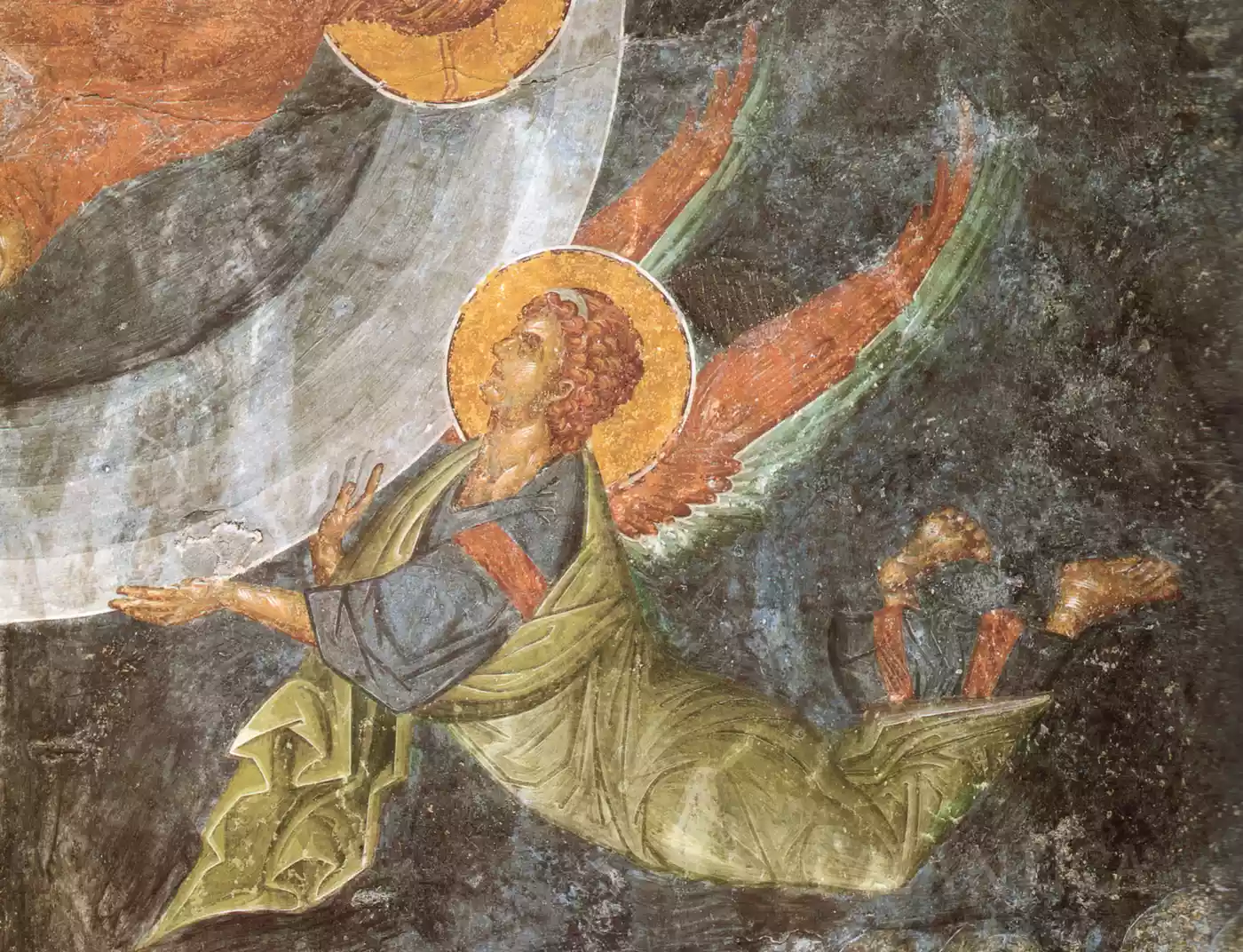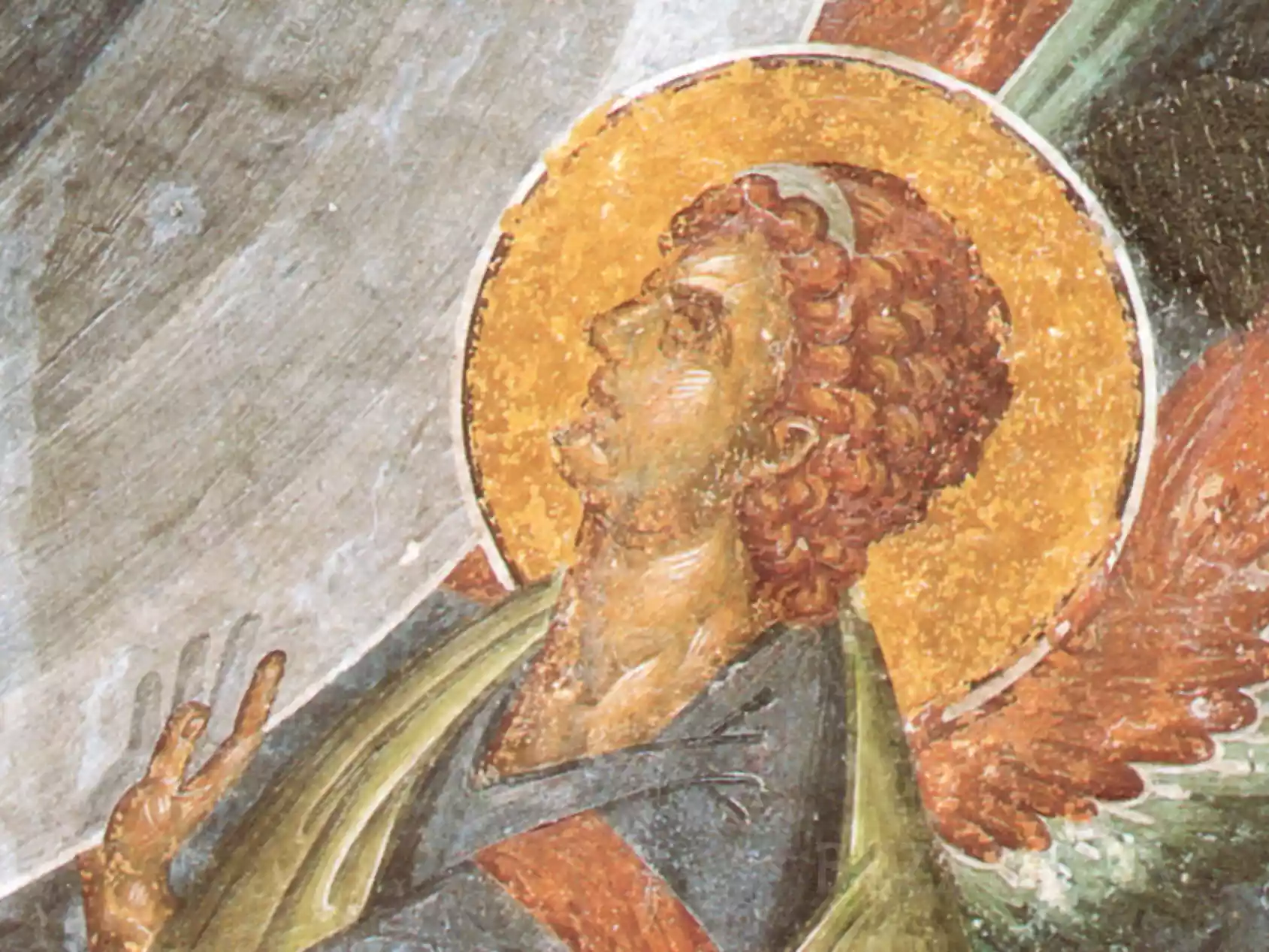
Title: Angel of the Ascension
Artist: Unknown (workshop of three painters)
Type: Wall painting
Date: circa 1430
Materials: Fresco
Location: Pantanassa Monastery, Mystras
The form as a palimpsest: Tracing the historicity of the image
In the Monastery of Pantanassa in Mystras, in that fragment of a fresco that delivers the image of an Angel—a memory of the Ascension—we do not simply behold the monumental representation of a theological idea. Around 1430, in the turbulent pre-midnight hour of the Empire, this image becomes something more: a material body, perishable and yet enduring, in which survives, almost like an echo, the silent turmoil of an era that is ending.
The work, integrated into a web of a mural programme which bears the traces of the collective labour of three artisans, cannot be confined to the category of a religious iconogram. It functions, rather, as a cultural document, an archive of aesthetic and technological choices, and even more so as a place of inscription of a collective ontology, that of the late Byzantine art society that, balancing between earthly precarity and its eschatological hope, transmutes the intangible into form.
Before this form, the modern viewer does not necessarily feel reverence, but that strange shiver of recognition—a humanity that insists on being preserved not only as a concept, but as a material touch, as an artistic deposit of hands that worked, of eyes that looked, of pigments that withstood time. The turn, therefore, which is attempted here, does not aim for desacralisation. On the contrary: it is a reading that extends spirituality into the corporeal, that reads the sacred not as an absence of history, but as a density of meanings that are born within historicity.
Let it not be forgotten that, as Bayet notes, the art of Byzantium lived not only thanks to its churches and palaces, but also thanks to the gestures of the form, the splendour of the colours, the sheen of the enamel and the geometry of the tesserae—that is, through the unbreakable network of arts and cognitions that connected art with its world.
The Materiality of the Image and the Conditions of Production
If we approach this fresco as a historical document—as an heirloom of workshop methodology and aesthetic intention—we shall ascertain that the form of the Angel does not merely constitute a theological metaphor. On the contrary, it embodies the preconditions of production of a specific artistic paradigm: the technical training of its creators, the access to materials (such as the rare organic pigments in green and orange tones), but also the economic dynamism of its commissioner. Nothing, not the technique of the fresco, not the density of the colour, not the precision of the brushstroke, is accidental. All these constitute a cultural indicator, a trace of the material life that surrounds the image.
In this sense, the form is not simply a result of divine inspiration, but also an embodiment of labour, collective and methodical. It functions as a palimpsest where, beneath the sacred narrative of the Ascension, the local society of Mystras is revealed; its commercial connections; the know-hows that were exchanged; and the historical fluctuations that imposed, at times limitations, and at other times opportunities for creation. The analysis of the trace of the brushstroke, of the layers of the plaster, even of the corrective insertions that possibly intervened during the work, illuminates art as an artisanal experience.
The Angel, therefore, does not descend from the heavens as a virtual projection of a dogma, but emerges from within the workshops, the dusts and the measurements of a real society. It is the memory of a historical conjuncture, not simply of a faith. From this perspective, it does not cease to be sacred; it becomes, however, sacred not despite its historicity, but precisely because of it.

Movement as a Metaphysical Declaration
I this mural, the form seems to vibrate. It does not remain within the confines of linear space, but escapes, suggestively, towards a dimension of fluidity, as if another body—intangible, pulsating—was moving in parallel with that of the pigment. The folds in the garments do not obey gravity but seem to be drawn by an imperceptible, celestial breath. The very posture of the body, with its subtle deviations and morphological tensions, produces a set of rhythms that functions not descriptively, but almost musically.
The artist is not content with representation; he penetrates the essence of the energy, the sensation of time that has been interrupted—not to stop, but to be captured in a moment of revelation. Thus, the Angel’s wings—artefacts of most delicate observation—are not decorative: they are bearers of meaning and momentum; they are landscapes of transference, where the earth ceases and the celestial begins. Theology here is transformed into an aesthetic embodiment of movement: the Ascension is not declared, it is imprinted. The divine does not appear as an idea; it happens.
The Language of Form and its Political Weight
This image, however, does not only express mystery; it also captures a regime. The movements, the postures, the arrangement of the figures within the composition, function as semiotic formations: they determine where the viewer stands, whom he sees and how. The Angel, with its restrained magnificence and the absolute balance between supplication and declaration, is not simply a messenger of the divine; it is a representative of a hierarchised world, where the celestial and the terrestrial are connected not unmediatedly, but through a symbolic civic structure.
The beauty of the work is not only artistic. It is rhetorical. And this rhetoric functions not only in favour of the divine, but also in favour of the order that the divine validates. The image is power in image. As Bayet also notes, the very splendour of late Byzantine aesthetics was proof of the prestige, not only of the artist, but also of the institution that produced it.
The Image as a Reflection of History
The fresco of the Angel of Pantanassa, when seen not only as a liturgical representation but as a historical document, reveals the subterranean routes that connect art with life. The religious character of the work is not lost—on the contrary, it is deepened, when we locate within it the presence of labour, of society, of politics, of decay. What seems motionless and transcendent, is revealed, ultimately, as an inscription of an era that still pulsates.
Art, here, does not call us to venerate it; it challenges us to read it. And this reading—slow, analytical, passionate—is also the act that renders the image true.
The Angel, with the body that hovers, the posture that indicates, the wings that tremble, does not merely testify to the Ascension. It testifies to the human history that imagined it, the technique that rendered it, the fear and the hope that framed it. And through this multiplicity, it does not rise only towards heaven; it returns also to us. Like a witness of time that fell silent, but was not silenced.
Bibliography
- Bayet, Charles. Byzantine Art. Google Books, 2023. https://books.google.com/books?id=_smjAwAAQBAJ&printsec=frontcover&dq=byzantine+art&hl=el&newbks=1&newbks_redir=1&sa=X&ved=2ahUKEwipmtXGtZSOAxUOJUQIHTZ9ADQQ6AF6BAgJEAM
- Beckwith, John, et al. Early Christian and Byzantine Art. Google Books, 1986. https://books.google.com/books?id=1kSpN3Kfgc0C&pg=PA363&dq=byzantine+art&hl=el&newbks=1&newbks_redir=1&sa=X&ved=2ahUKEwi4gfjXtZSOAxXMEkQIHWliEic4FBDoAXoECAcQAw
- De Marco, Pasquale. Art, Empire, and Faith: Exploring the World of Byzantine … Google Books, 2025. https://books.google.com/books?id=u_lOEQAAQBAJ&pg=PA103&dq=byzantine+fresco+art&hl=el&newbks=1&newbks_redir=1&sa=X&ved=2ahUKEwjejYnztZSOAxV-NEQIHR1fHxUQ6AF6BAgFEAM
- Oman, Charles. The Story of the Byzantine Empire. Google Books, 1892. https://books.google.com/books?id=Uj_PAAAAMAAJ&pg=PR16&dq=byzantine+fresco&hl=el&newbks=1&newbks_redir=1&sa=X&ved=2ahUKEwjg59HktZSOAxVuC0QIHd17HM8Q6AF6BAgNEAM
- Skawran, Karin M. The Development of Middle Byzantine Fresco Painting in Greece. Google Books, 1982. https://books.google.com/books?id=wPvqAAAAMAAJ&q=byzantine+fresco+art&dq=byzantine+fresco+art&hl=el&newbks=1&newbks_redir=1&printsec=frontcover&sa=X&ved=2ahUKEwjejYnztZSOAxV-NEQIHR1fHxUQ6AF6BAgLEAM
FAQ
What makes the Ascension Angel in Pantanassa historically significant?
The Ascension Angel represents a pinnacle of late Byzantine art, created around 1430 during the final flowering of Byzantine culture before Constantinople’s fall. Its exceptional preservation allows art historians to study authentic 15th-century painting techniques unaltered by later interventions. The angel exemplifies the distinctive Mystras school of painting, which synthesized traditional Byzantine iconography with innovative artistic approaches that would influence post-Byzantine religious art throughout the Eastern Mediterranean.
How does the angel’s composition in the Ascension scene work aesthetically?
The angelic figure is masterfully integrated within the overall Ascension composition through sophisticated color harmonies and dynamic spatial arrangements. The artist positioned the angel to direct viewers’ attention toward the ascending Christ while creating visual balance with other figures. The elegant posture, expressive gestures, and carefully rendered drapery demonstrate advanced compositional understanding. This thoughtful arrangement exemplifies how Pantanassa’s artists achieved both theological clarity and visual harmony within their monumental painting program.
What painting techniques were used to create the Pantanassa’s angelic representation?
The artist employed a distinctive watercolor-like fresco technique that creates an ethereal, luminous quality unique to Pantanassa’s decoration. Light, transparent layers of mineral pigments were applied to fresh plaster using fine brushwork with exceptional control. The angel’s face shows subtle modeling through delicate transitions between light and shadow. Golden highlights, applied as precise, metallic-looking clusters, define forms without destroying the overall atmospheric effect that characterizes these remarkable 15th-century paintings.
Why are the colors in the Ascension Angel so distinctive?
The Pantanassa Ascension Angel displays an innovative color palette featuring bright, unsaturated hues—particularly almond green, subtle purple tones, and luminous ochres—that distinguish it from earlier Byzantine works. These lighter, more transparent colors create an airy impression while simultaneously conveying spiritual radiance. The artist manipulated color relationships to suggest divine light emanating from within the figure rather than being merely illuminated from outside, representing an important development in Byzantine painting’s approach to depicting celestial beings.
Who created the Ascension Angel in the Pantanassa Monastery?
While the specific artists remain anonymous, art historians have identified at least three distinct painters who collaborated on Pantanassa’s decoration. The Ascension Angel displays characteristics attributed to “Painter A,” recognized for classical proportions and refined technique. This master artist likely led a workshop that included apprentices and specialists working under his direction. The collective nature of Byzantine artistic production means that while individual hands can sometimes be distinguished, the work represents a collaborative process guided by established iconographic traditions.
How can visitors best appreciate the Angel of the Ascension at Mystras today?
Visitors to Mystras can experience the Ascension Angel within its original architectural context in the Pantanassa Monastery, which remains a functioning religious site. Morning visits offer optimal natural lighting conditions that reveal the subtle color transitions and atmospheric qualities of the painting. Binoculars help appreciate details that might otherwise be missed due to the height of the composition. Understanding the iconographic program before visiting enhances appreciation of how this particular angelic representation functions within the broader theological narrative expressed throughout the church’s decoration.
Bibliography
- Asteriadēs, A. (1999). Zōgraphikē, charaktikē. Athens.
- Beigbeder, O. (1995). Léxico de los símbolos. Madrid.
- Byron, R., & Talbot Rice, D. (2013). The Birth of Western Painting (Routledge Revivals): A History of Colour, Form, and Iconography. London: Routledge.
- Hoffmann, T. (2012). A Companion to Angels in Medieval Philosophy. Leiden: Brill.
- Peers, G. (2001). Subtle Bodies: Representing Angels in Byzantium. Berkeley: University of California Press.
- Vardavakē, M. A., & Εμμανουήλ, Μ. (2005). Η Μονή της Παντάνασσας στον Μυστρά: οι τοιχογραφίες του 15ου αιώνα. Athens.
- Archaiologia – Τεύχη 82-85. (2002). Athens.
